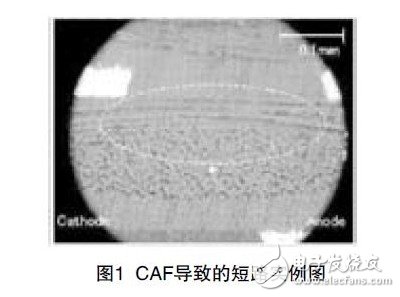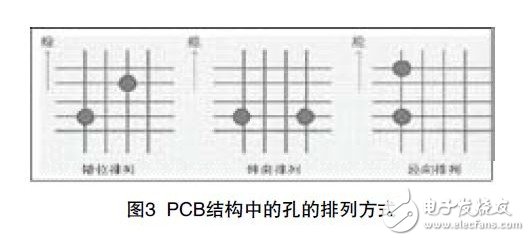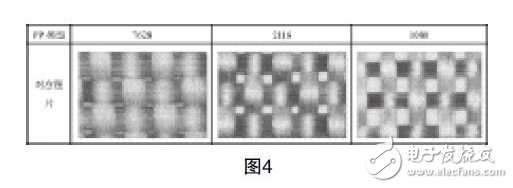1 Introduction
In the field of electronic equipment, taking automotive electronics or some military equipment as an example, it has high requirements for high temperature and high humidity environments. With the development of such products towards higher density, the pitch of the holes is getting smaller and smaller, which makes the reliability requirements of the printed board to the holes correspondingly improved, so the conductive anode filaments produced by the printed circuit boards become the reliability of the products. Key factor.
Conductive anode wire (English abbreviation: CAF; full name: ConducTIveAnodic Filament) refers to the copper inside the PCB from the anode (high voltage) along the microfissure channel between the glass filaments, copper and copper during the migration process to the cathode (low voltage) The leakage behavior of copper salts. When the PCB/PCBA is energized in a high-temperature and high-humidity environment, a serious CAF may be generated between the two insulated conductors along the resin or glass fiber interface. This phenomenon will eventually lead to poor insulation or even short-circuit failure.
The short circuit caused by CAF is shown in Figure 1.

2 CAF failure mechanism
2.1 CAF failure mechanism
The CAF production process can be studied in two steps, namely the formation of ion migration channels and the growth of anode filaments.
(1) Chemical bond hydrolysis.
Under high temperature and high humidity conditions, the adhesion between the resin and the glass fiber deteriorates, and the silane coupling agent on the surface of the glass fiber is hydrolyzed, resulting in the generation of an electrochemical migration path (ie, a channel for copper ion migration). .
(2) Conductive anode wire growth.
After the ion migration channel is generated, if there is a potential difference between the two insulating holes at this time, the copper on the anode having a higher potential is oxidized to copper ions, and the copper ions migrate to the cathode having a lower potential under the electric field. In the process of migration, it combines with impurity ions or OH- in the plate to form a water-insoluble conductive salt, and deposits it, so that the electrical spacing between the two insulating holes is drastically lowered, and even direct conduction forms a short circuit. At the anode. The electrochemical reaction of the cathode is shown in Figure 2.

2.2 Factors affecting the formation of CAF
For finished PCBs, the main factors affecting the formation of CAF are:
PCB design, sheet metal, PCB processing. The following analysis of these influencing factors.
2.2.1 Impact of PCB design
In the structure of the PCB, the arrangement of the holes has a great influence on the performance of the CAF, and the arrangement of the holes is different. The CAF effect is different, and generally there are three arrangements (as shown in FIG. 3). The order of resistance to CAF performance in the three arrangements is from strong to weak: misalignment arrangement "latitude arrangement" is arranged in the warp direction. The reason is as follows.

(1) The occurrence of CAF is mainly along the direction of the glass yarn bundle. The misalignment arrangement can form a detour to the generation of CAF, so that CAF failure is not easy to occur.
(2) Compared with the warp direction, the weft glass yarn has better wettability of the resin, and the crack of the drill hole is also slightly milder than the warp direction, so the CAF resistance is better.
2.2.2 Influence of sheet metal distribution
It is well known that copper clad laminates are pressed from prepreg and copper foil, and different prepregs have a large difference in CAF properties depending on the woven structure of the fiberglass cloth used.
The following are the physical weave structures of three common fiberglass cloths. The resin content and wettability advantages of these three braided structures are compared (Fig. 4): 1080>2116>7628, that is, 1080PP sheets are the least prone to CAF failure.

2.2.3 Impact of PCB processing
The tiny voids created between the glass fiber and the resin surface during PCB processing have a great influence on CAF performance, including the following aspects:
(1) Pressure when pressing the plate. The heating rate and the curing temperature and time of the high temperature section have an effect on the CAF performance, but the most affected is the curing temperature and time of the high temperature section.
(2) Degumming parameters: The suitability of the glue removal parameters directly determines the cleanliness of the hole walls, which in turn affects the wall roughness.
(3) Hole wall roughness: In addition to the rubber removal parameters mentioned above, the hole thickness also depends on the drilling parameters and the number of times the drill bit is ground. The larger the hole wall roughness, the more likely the CAF failure occurs.
Resistor (Resistor) commonly known as resistance directly in our daily life.It is a current limiting element. When the resistance is connected to the circuit, the resistance value of the resistor is fixed, usually two pins.Fixed resistors are those whose resistances cannot be changed.Resistance variable is called potentiometer or variable resistor.The ideal resistor is linear, that is, the instantaneous current through the resistor is proportional to the applied instantaneous voltage.Variable resistor for partial pressure.On the exposed resistor body, one or two movable metal contacts are pressed tightly.The contact position determines the resistance between any end of the resistance body and the contact.
Electronic Components Resistor
Electronic Components Resistor,Metal Film Resistor,Metal Oxide Film Resistor
YANGZHOU POSITIONING TECH CO., LTD , https://www.yzpstcc.com